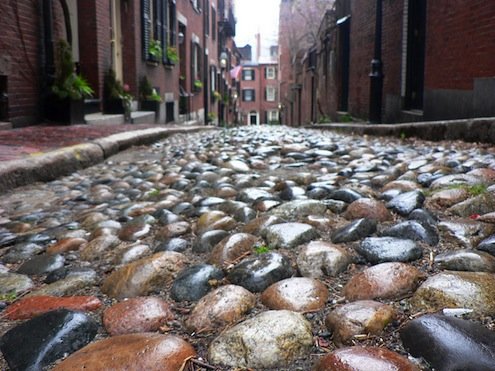

We may earn revenue from the products available on this page and participate in affiliate programs. Learn More ›
A walk through the historic districts of many older American cities will reveal a rustic and romantic street standard of the past: cobblestones.
Cobblestones date back to ancient times, with many pre-Roman cobbled streets dating back to the 3rd and 4th centuries. They’ve been used worldwide throughout history—mainly in Europe but also in Latin America—and are still in use and painstakingly maintained (stones are replaced and arranged by hand).
Most strictly defined, cobblestones are rounded, water-worn stones used to pave streets. They were traditionally set in sand and sometimes bound with mortar. And there were many advantages to using them. Cobblestone streets did not develop ruts, nor did they get muddy or dusty, like dirt roads. Sand-set cobblestones make a permeable and “flexible” road surface; they don’t crack with movements in the ground due to freezing and heaving. Cobblestones are noisy, though, which would seem a terrible disadvantage, but the clatter of hooves and cars over cobblestones does warn pedestrians to make way.

Cobblestones eventually fell out of favor for quarried granite setts, or Belgian block, which are relatively regular, rectangular stones laid out in a pattern. These made for a much smoother and safer ride than cobbles in the 19th century and are what most people refer to as “cobblestones” today.
Cobblestones were not only relegated to the streets. In areas where glaciers have retreated, like the Finger Lakes region of New York, there were ample rounded cobblestones available for building. The supply helped build homes, taverns, factories, schools, churches and other structures throughout parts of New York State and Canada.
Cobblestones have their place in modern applications today. They’re used in restoration, of course. But they are often used in new city plazas, parks, and malls as a stand-out design element. That design influence has even reached residential driveways and patios. With this growing market, both salvaged and new cobblestone materials can be found now with increasing ease and decreasing expense.
So if you love those romantic strolls through the cobbled streets of America’s older cities, you can bring a bit of that old world charm, literally, right to your doorstep.
For more on paths and pavers, consider:
Patio Pavers 101
10 “Best in Class” Patio Pavers
Garden Paths: 12 Easy-to-Imitate Stone Walkways
